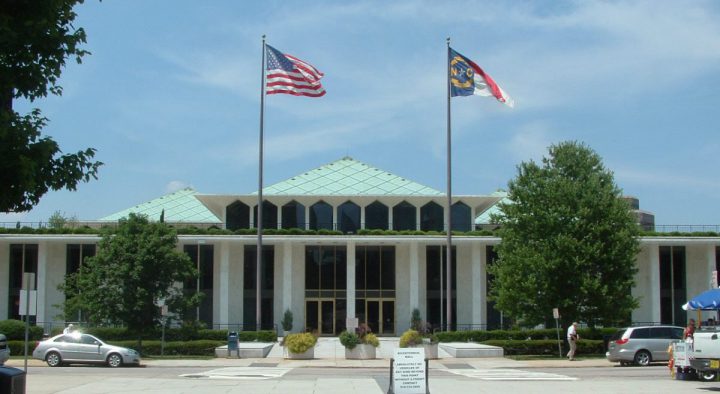
RALEIGH – Legislators are set to reconvene in Raleigh after Thanksgiving as more details are compiled in steadily increasing estimates of the damage from Hurricane Florence and Tropical Storm Michael.
The General Assembly, which returns Nov. 27 for a previously scheduled post-election extension of its 2018 regular session, is expected to approve another spending package that would draw from roughly $395 million set aside but not allocated in a one-day session in mid-October. The session could extend into the first week of December.
Supporter Spotlight
During the session, the legislature appropriated about $400 million aimed mainly at replenishing state matching funds for federal help, but legislators avoided some of the more controversial and potentially expensive topics under consideration by the legislature and the Cooper administration.
Those include buyout programs for residences, businesses and agriculture operations, moving sewage treatment plants and infrastructure out of floodplains and potentially sweeping changes to waterway debris removal and river basin management.
During a review Tuesday in Raleigh by the Joint Oversight Committee on Agriculture and Natural and Environmental Resources, legislators received an update on estimates for farm damages, stream debris removal, derelict boats and the effects on water and wastewater infrastructure and commercial fishing operations.
In a breakdown of what happened at public water and wastewater facilities, Jim Gregson, deputy director of the Department of Environmental Quality’s Division of Water Resources, said wastewater system bypasses and sanitary sewer outflows dumped nearly 88 million gallons of untreated wastewater into surface waters in the state.
Gregson stressed that much of that water was heavily diluted by the volume of water from the storms, but the spills put the viability of some systems and their ability to weather storms into sharper focus.
Supporter Spotlight
Of the 758 water systems in the 58-county area disaster area, 98 had to rely on backup power to continue to function and 20 ran out of water as Hurricane Florence moved into the area.
A week after the storm, 16 systems were still not producing water, six were without power, 28 were operating on backup power and eight reported pressure problems.
Damage to the 474 wastewater treatment plants in the area left 24 systems only partially operational and 15 non-operational a week after the storm.
There were 516 overflows recorded, with major spills at Jacksonville and High Point, Gregson said.
Gregson said that about 3,000 of the state’s 3,300 wastewater lagoons at large-scale livestock operations were in the affected area. Six operations saw discharges because of either full or partial breaches, 32 lagoons were overtopped by floodwaters and 10 lagoons were inundated.
Rising floodwaters that lasted weeks after the storm left some operations flooded for more than three weeks after the storm, Gregson said.
Some legislators said concerns about animal operations were overblown, given the size of the problem with wastewater failures.

“Why are we having so much focus on animal facilities, why aren’t we having more focus on wastewater treatment plants?” Sen. Andy Wells, R-Alexander, asked during the meeting.
Wells also asked DEQ officials whether they were allowing state funds to be spent on rebuilding any wastewater treatment plants within the 100-year floodplain.
Kim Colson, DEQ’s director of the Division of Water Infrastructure, said that the top priority was rehabilitation and replacement of aging infrastructure.
“In many cases that aging infrastructure, if it is prone to flooding, will be moved either out of the floodplain or better protected,” he said. Most would be protected and not moved, he added, in part because of Federal Emergency Management Agency rules.
In an interview last month with Coastal Review Online, Grady McCallie, senior policy analyst for the North Carolina Conservation Network, said the environmental group would continue to push for moving large-scale animal operations, including the state’s growing number of poultry operations, out of the floodplain.
“It’s time to get all of the swine and poultry operations out of the 100-year floodplain,” he said.
At the same time, the state needs to push for conversion to better methods for dealing with the waste, he said. That should be a part of any plan as well because some of the operations that were damaged and flooded were outside of the floodplain.
Gov. Roy Cooper has also called for an increase in funding for an ongoing buyout program that’s seen little success in recent years due in part to lack of funding.
Cooper and DEQ Secretary Michael Regan have also pushed for additional funding to move wastewater infrastructure out of floodplains.
Gregson also gave legislators an outline of the growing needs assessment for beach re-nourishment, inlet dredging and flood mitigation in coastal regions.
An ongoing compilation of the costs to re-nourish eroded beaches has reached $290 million and channel dredging costs are estimated at $62 million.
Gregson said local governments are continuing to conduct estimates and are working with FEMA and the Army Corps of Engineers to determine funding options.
Agriculture and Aquaculture Support
One of the largest parts of any future recovery package is reimbursement to farmers to cover agricultural losses. The legislature set up the structure for a payment program in last month’s recovery package but didn’t fund it, instead waiting on state Agriculture Commissioner Steve Troxler to provide additional details on the program.
Troxler told legislators Tuesday that the funds are needed soon, in part to settle with lenders in order to finance next year’s operations. He estimated that the final cost of the recovery package for farmers would be $250 million.
While some of those funds would go to aquaculture operations, coastal legislators on the committee expressed concern that much of the losses in commercial fishing and oyster harvesting won’t be covered.

Steve Murphey, director of the Division of Marine Fisheries, said the division was compiling estimates of the losses to commercial fishing and shellfish operations based on trip tickets, but that’s not likely to capture all the losses.
“The total impact is very hard to put a total figure on, but we know it is going to be significant,” Murphey said.
He said the historic, 2013-17 averages for commercial seafood harvests during September was around $10 million. The impact for shellfish leaseholders in public trust waters was roughly $3.5 million.
There’s also a lot of damage to infrastructure, he said.
“There’s a lot of seafood houses out there missing docks. They couldn’t service the boats even if they did go fishing,” Murphey said.
The damage didn’t end after the storm subsided, he added. There’s damage both to the fishing infrastructure and a significant impact on the ecosystems that support the fisheries.
“What we see when this amount of fresh water hits an ecosystem is that it displaces a lot of fish,” Murphey said. “So, if you’re a crabber in Craven County on the Neuse River, you’re not going to have a very good fall because those crabs are already down in the sound somewhere.”
Experience shows that the storms’ effects on fisheries continue into the following years, he said.
Sen. Bill Cook, R-Beaufort, said he would like to see more money allocated for the shellfish industry.
The state has so far allocated $1.6 million for losses to both commercial fishing operations and shellfish harvesters. Cook noted that the amount would be split between the two groups when the loss to the shellfish harvesters alone is estimated at $3.5 million.
“Oysters have had a devastating year,” he said. “Many of these guys lost the whole kit and kaboodle. Is there any way we can adjust this?”
Murphey said if more money is appropriated the funding could be easily “scaled up,” but he agreed that the amount allocated so far would only cover a fraction of the cost.
“Basically $1.6 million would cover the week that they took off to prepare for the storm,” he said.







